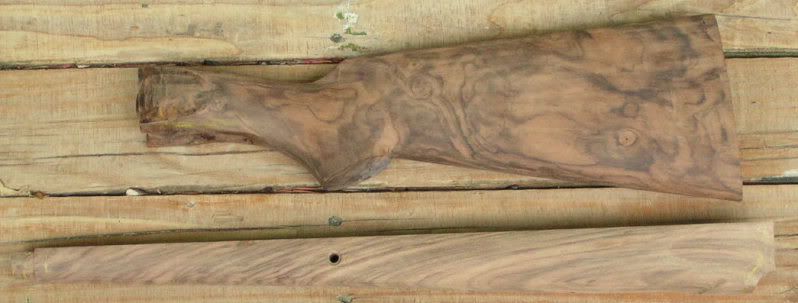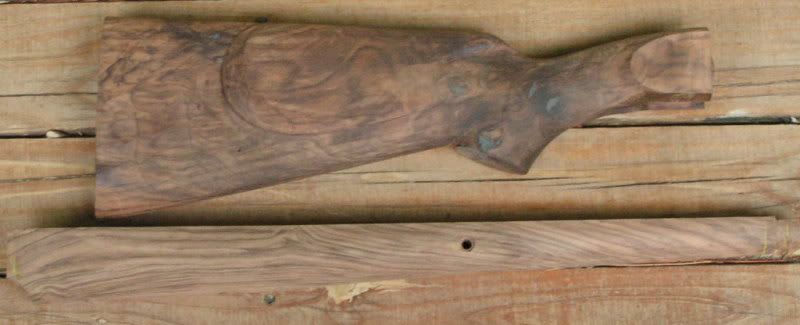31 October 2009, 06:25
Kiwishooter2Ruger #1 stock
I have a Ruger #1 that started life as a 26" barreled 223, it is becoming a Mannlicher in 222 Rem Magnum.
Below is what the stock looks like after the bits that didn't look like a stock were removed.
The fore end is quite a bit lighter in colour than the butt stock.


31 October 2009, 07:13
degoinsvery nice!!! that is gonna a be a real beauty!! keep us posted all the way.....and thanks for sharing.
02 November 2009, 05:13
RockdocKiwi, that looks really nice. Did you do it yourself? NZ walnut I presume?
Look forward to progress story and pics. Cheers, Chris
02 November 2009, 10:39
Kiwishooter2Hi Chris, No it is actually Turkish Walnut, my next one will have NZ walnut I already have the blank for it.....Cheers Kiwi
05 December 2009, 03:54
ldkierI bet you can bring the forestock to the buttstocks shade with a fine stain. To compare the shade of the Buttstock to the forestock; I think you could dilute Sherell's Shaftol reddish brown with about 20% clear Shaftol for the forestock and have the same shade as the buttstock. You could then finish both with Sherell's premium gold....thats if you want to use Shaftol....Just a suggestion.
Good Luck, Lyle
07 December 2009, 11:59
Kiwishooter2Hi Lyle, I haven't heard of Sherell's products where do you get it from?....Thanks Kiwi
07 December 2009, 20:51
ldkierSherells is a German product. Look at their web-site
www.schaftol.de or
www.ballistol.deGood Luck,
Lyle
17 December 2009, 19:31
El Deguelloquote:
Originally posted by degoins:
very nice!!! that is gonna a be a real beauty!! keep us posted all the way.....and thanks for sharing.
I believe that forend will darken a bit when finished.
18 December 2009, 20:55
Chris K'nerrHere in the shop when having to add color or match shading, I use several colors of tint. The idea is not to change what mother nature has given to you, just add to it.
They are all alcohol solvable colors like Transtint or something of the ilk. The ideas is to add those tints according to grain density. Want to leave what is already there, just want to add to it. By using several colors, you prevent the appearance of having stained the wood. It will look natural. The first color to go on is the lightest. I try to use something as close to the base color of the wood as possible. I want it to soak in and fill the pores/grain. It will obpretty much obscure whatever color and grain pattern is in the wood. When it dries lightly sand. I go down to just barely seeing details of the original wood's grain pattern. Only want to expose some of the harder grain. Next is a reddish colored tint to add warmth and expand the color pallete in the wood - Red mahogany, french red, etc. custom mix if you want. Reddish colors blend nicely with all manner of the things to produce a complex pallette. This color is applied thoroughly, but not so much as the first color. Remember the softest grain is already full of the first color. This color won't penetrate so deeply. Let dry and lightly sand again. You can see why you have to get the first color to really soak in. This sanding is just a light dusting. Then the darkest color goes on. Dark Chocolate brown for walnut. When all has dried, I then sand down to the shade I want. Because both pieces of wood have the same tinting, they will have an eye fooling shading that makes them seem to be from the same blank. It also takes on a warmer appearance and now has a complex range of colors that is very eye appealing. One thing to note - don't worry too much about getting rid of too much color. There is more there then you think. As you are sanding through the darker colors, you are redepositing some of the colors you are sanding off. They will be suttle, but still there. Set it aside for a few hours and come back to it. There will be a lot still left. Anyway, I still stop a little early and start with finish. I count on sanding through the finish to wood several times to get the shading I want. When that is good to go, apply finish as needed. One other thing to consider, when finishing don't wet sand. That creates a small amount of fogging. Subtle, but it is detectable - especially in bright sunlight. The color is all in the wood, why hide it? You will use a lot more sandpaper, but the end result is well worth it!
If the stripes in something like tiger tail maple are starting to fade (mother nature can be cruel), a 4th color can be added - something ridicules like cordovan makes them stand out even more. I have to point out the color since no one in the last 20 years has notices on some muzzle loader stocks.
I am new to this board, so don't know how much commercial stuff I can post here. If you will email me, I can supply more details and hopefully stay out of hot water. I am a stockmaker by trade.
Best of luck,
Chris
19 December 2009, 09:39
Kiwishooter2Hi Chris,
Thanks for the advise it is much appreciated, I have sent you an email.....Kiwi

